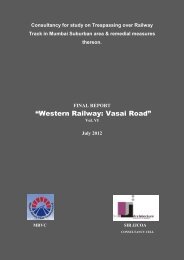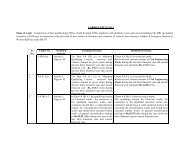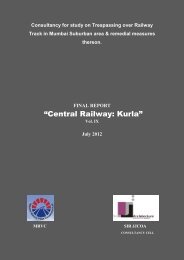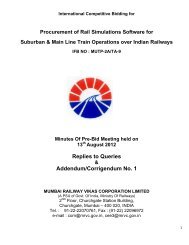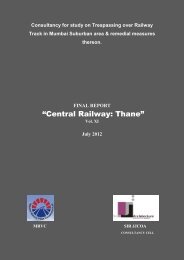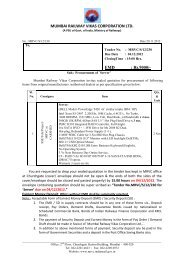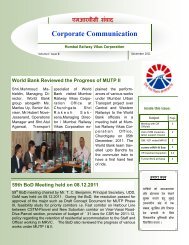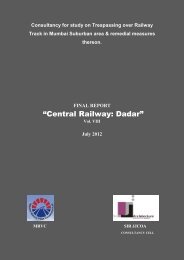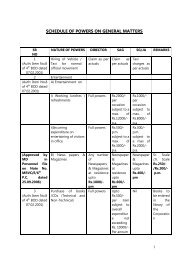World Bank Document - Mumbai Railway Vikas Corporation Ltd ...
World Bank Document - Mumbai Railway Vikas Corporation Ltd ...
World Bank Document - Mumbai Railway Vikas Corporation Ltd ...
You also want an ePaper? Increase the reach of your titles
YUMPU automatically turns print PDFs into web optimized ePapers that Google loves.
elow “critical”. Although sulfur dioxide (SO 2 ) and nitrogen dioxide (NO 2 ) levels are still within<br />
reasonable limits 21 , current motorization trends are not environmentally sustainable. 22<br />
84. “In <strong>Mumbai</strong> the main contributor of air pollution is the transport sector, followed by<br />
power plants, industrial units and the burning of garbage.” 23 Irrespective of improvements in<br />
engines and fuel type, ambient air quality is bound to further deteriorate because of the<br />
motorization rate if no compensatory action is taken. Understanding the need for a sustainable<br />
urban development strategy, in 2004 MMRDA retained the National Environmental Engineering<br />
Research Institute to prepare strategies and an action plan for particulate matter reduction in<br />
MMR. The study included assessment of ambient air quality status (especially for particulate<br />
matter PM10), the development of reduction and mitigation strategies, and a reduction action<br />
plan.<br />
85. Developing suburban rail use would contribute to the efforts being made in India as well<br />
as in other countries to reduce GHG emissions. MUTP-2A aims at expanding an energy-efficient<br />
public transport system and minimizing motor vehicle use, the main source of pollution. Indeed,<br />
as presented in Annex 9, expanding the rail network capacity will likely lead to a diversion of<br />
passengers from bus services. This reduction in bus operations will in turn contribute to reducing<br />
pollution, because EMU trains emit very limited pollutant quantities, whereas buses emit NO 2<br />
and SO 2 at a rate of 0.25 kg per bus per hour.<br />
86. Finally, the conversion from DC to AC will allow the use of more energy-efficient trains,<br />
thus further decreasing CO 2 emissions and allowing MRVC to claim carbon credits. The energy<br />
saving per year due to the trains already introduced at this point is estimated at 6.2 million kWh,<br />
and this allows for a generation of carbon credits equivalent to 62.6 thousand tCO 2 e 24 per year. 25<br />
Long-term Transportation Strategy for MMR<br />
87. Within the next 25 years, <strong>Mumbai</strong> is projected to overtake Tokyo and become the largest<br />
urban region in the world, in a country having one of the fastest expanding global economies. In<br />
2004, a task force appointed by the Chief Minister of Maharashtra conducted a comprehensive<br />
transportation study for the metropolitan region known widely by the acronym TranSforM (for<br />
21 The concentrations in SO 2 and NO 2 are 9 μg/m 3 and 42 μg/m 3 in 2008 respectively. Both levels are currently<br />
labeled as “low” (between 0 and 40 μg/m 3 ).<br />
22 “According to a study carried out by EMBARQ in cooperation with the <strong>World</strong> <strong>Bank</strong> in 2007, continuation of the<br />
rapid motorization trends without adequate policy and technological interventions (the “business-as-usual” scenario)<br />
would increase the annual national CO 2 emissions from urban transport sector (in all major cities) to 254 million<br />
tons of CO 2 in 2030, which is more than nine times the emissions level in 2005.” (Project Appraisal <strong>Document</strong>,<br />
Sustainable Urban Transport Project, <strong>World</strong> <strong>Bank</strong> 2009).<br />
23 Larssen et al., URBAIR Urban Air Quality Management Strategy in Asia: Greater <strong>Mumbai</strong> Report, <strong>World</strong> <strong>Bank</strong><br />
1997.<br />
24 tCO2e: Tons of CO 2 equivalent is a measure for describing how much global warming a given type and amount of<br />
greenhouse gas may cause, using the functionally equivalent amount of carbon dioxide as reference.<br />
25 MRVC Letter to <strong>World</strong> <strong>Bank</strong> dated May 16, 2008 regarding Generation of Carbon Credits on account of energy<br />
saving due to DC/AC conversion on <strong>Mumbai</strong> Suburban section of CR WR under MUTP 1 and 2.<br />
24





